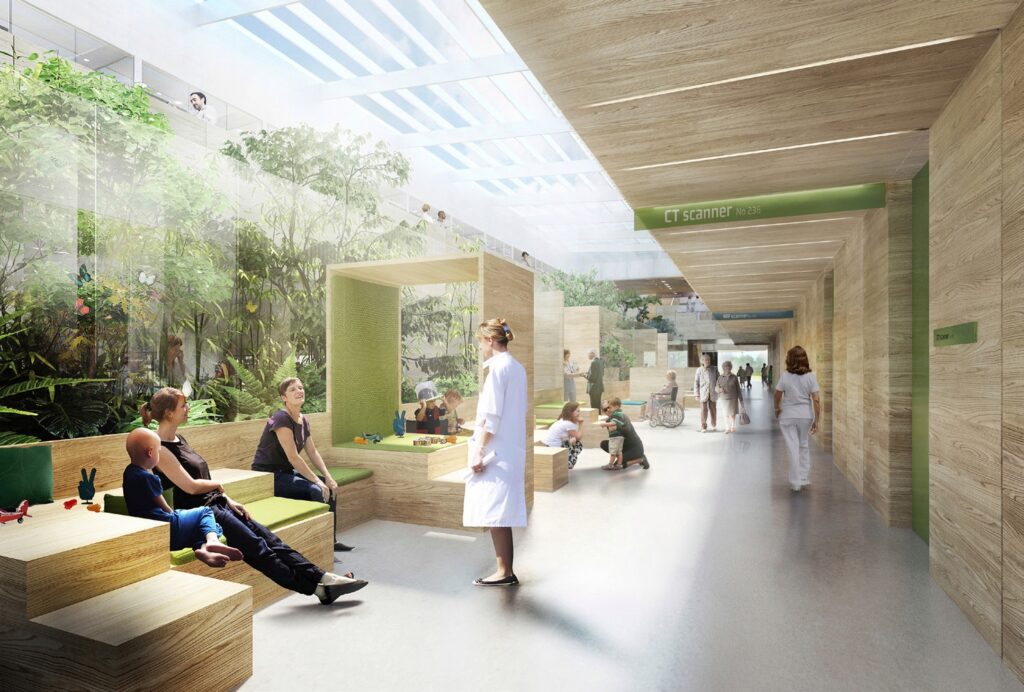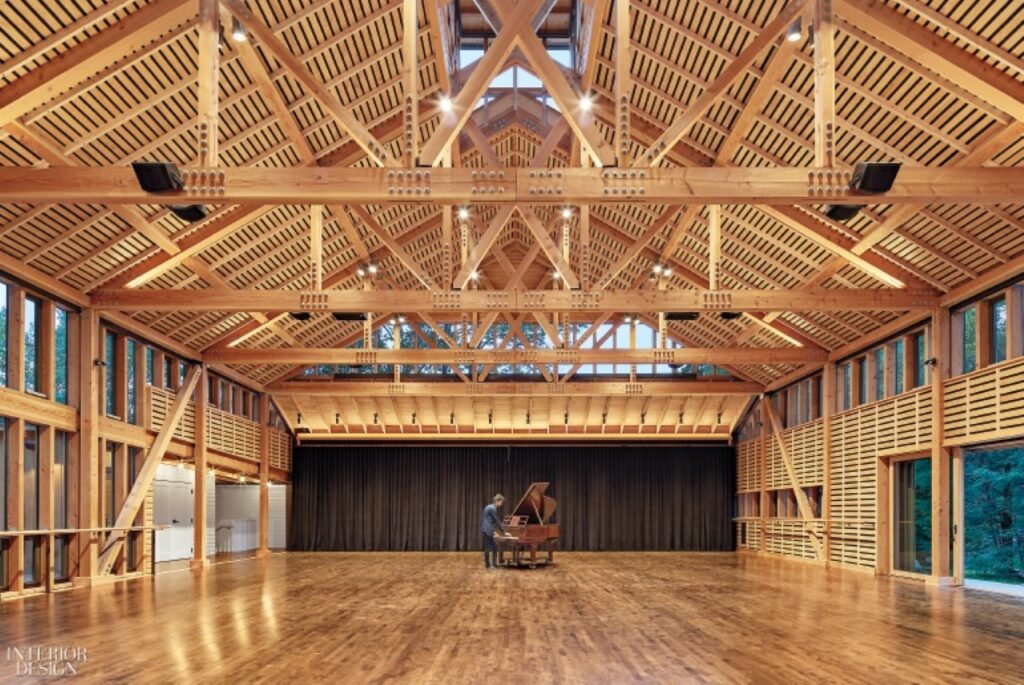Table of Contents
Introduction
A built environment that is more people-centered, to identify and incorporate all those spatial elements that interact with people on a physiological, as well as the psychological level, is what makes up therapeutic architecture. The term ‘therapeutic architecture’ was coined by Kate Johnstone, one of the rare architects with a Ph.D. in healthcare architecture.

The Journey From Healthcare Architecture To Therapeutic Architecture
Healthcare architecture was the next stepping stone of medical architecture. While focusing keenly on the patient’s treatments, the medical community realized that the physical space, architecture, and its feel are equally important in healing.
This realization turned into the eureka moment and encouraged the re-evaluation of the significance of architecture. It even showed how the design of the environment design can be beneficial not only for the patients but also the staff!

Role Of Architecture In Healing Process
Architecture is art with various aspects, as it is a creative amalgamation of various fields (i.e., science, aesthetics, technology, and human needs). Architecture and art, if woven together well, can create beautiful and meaningful spaces that have an impressive psychological impact.

The religious structures from bygone eras, like the churches, temples, and mosques, stand as proof of architectural marvels while embracing the sense of royalty, glory, and peace! The enchanting details of such spaces are meant to evoke positive feelings and emotions and have never failed to fascinate historians, travellers, and researchers all over the world!
Humans give more preference to lifestyles revolving around already built environments rather than natural environments. Isn’t it obvious by the fact that most people would get attracted to shopping complexes rather than natural parks?

Humans achieve nuances by innovative and fresh development. Little do we know that towards urbanization is making us highly dependent on technology. This has been turning our lives fully mechanized with busy work schedules, unheaved toxicity, diminishing green spaces, and congested and haphazardly planned environments. The long-term effect of this turns out to be an assorted package of health issues, and believe it, that’s not a package you don’t want to receive. Not only this, these conditions lead to overindulgence in medication, chemicals, and health care centers.

The ever augmenting population and their dependence on medicines to treat illness give us another reason to start relying on natural means, treatments, and therapies. The new trends don’t only focus on aesthetic embellishments to reduce stress and anxiety, but also make efforts towards promoting patient’s health and healing mechanisms. These spaces act as a medium to instill emotions that are the feel of a space, which brings positivity and peace in a person’s perspective and mood.
For a well-planned health care architecture, architects and researchers carefully observed and analyzed the correlation between the physical parameters and their effects on the patients (comfort, recovery, duration, medication, etc.). This can be done by individual examination of patients from all age groups, which helps design physiologically and psychologically healthy spaces for a comfortable and complete recovery.

Open Spaces
Studies have succeeded in proving the optimistic effect of nature and outdoor exposure helps in the patient’s healing process as it distracts them from stress and anxiety caused because of their ailments. A study published in the American Journal of Alzheimer’s Disease and Other Dementias stated that aggressive behavior in dementia patients can be reduced by playing recorded sounds of nature. I mean, who doesn’t feel calm by the rippling sounds of waterfalls or the mellifluous chirping of birds?

Another study proved that views of eye and mind soothing scenes such as magnificent mountains/hills and pretty sunsets activate the nerve cells of the brain and all the natural painkillers start gushing, reducing the stress levels, making one calm.
Light
Light plays a crucial role in the daily lives of humans, and their existence depends on it. It allows us to function at a basic level and has a major role in our health, both psychologically and physiologically.
Importance Of Natural Light
A study states that 92% patients put forward their thoughts, stating that sunlight seems to be pleasurable and calming. But only 31% of staff members think of sunlight as a positive light whereas the rest of the staff reasoned that sunlight is a nuisance and unfavourable.

Importance Of Artificial Light
Artificial lighting, of course, should be as accommodating and adaptable as possible and shall be placed as per the purpose of the space in question. In healthcare architecture, it should provide the patients and the staff members as required. Like the same light cannot be used for both reading (for patients) and surgeries/ examinations (for staff).
Fenestrations
‘Power of the window’ by Ulrich proves that patients in healthcare centers recover faster when their rooms have direct views of the natural environment rather than having blank walls in the view.
Another detailed study shows that the patients who could sense the nature (see, feel, hear and smell) around them, like the cool breeze, the peachy sunsets, mellifluent birds, and the sweet fragrance of the blooming flowers, required less pain medication than the ones in a room with no windows!
Colour
Colours have a noteworthy impact on the patient’s subconscious as different colours initiate different activities and instill different emotions and feelings. As the colour therapy states, colours possess the power to influence different aspects of our lives, from our emotions to our energy levels and even our mental state! The concept of colour therapy has been established on the fact, that the human’s physiological behavior acts in response to colours.
Each colour is said to be in line with 7 energy chakras. Let’s dive a little deeper in the ocean of these 7 chakra colours and there meanings.

Root Chakra
Location: Base of your spine near your tailbone
Colour: Red
Meaning: This chakra represents your security and your power base. It determines your ability to feel calm, safe, and grounded. It’s also from where you’re able to pull in energy and manifest your desires.
Sacral Chakra
Location: Two inches below your belly button
Colour: Orange
Meaning: This chakra represents and governs your emotional state and sense of creativity.
Solar Plexus Chakra
Location: Between naval and sternum
Colour: Yellow
Meaning: This chakra is indicative of personal power and will power, self-esteem, confidence, and intellect more generally. As for its associated colour, yellow, its connection is more symbolic—think of seeing a bright light, as in coming to a great idea or solution.
Heart Chakra:
Location: Center of chest
Colour: Green
Meaning: This chakra also represents the ability to give and receive compassion, expansion, empathy, service, kindness, health, and healing.
Throat Chakra:
Location: Base of the throat to the centre of the eyes
Colour: Blue
Meaning: This chakra is all about self-expression and clear communication.
Third Eye Chakra:
Location: Centre of forehead between eyebrows
Colour: Indigo or purple
Meaning: The third-eye chakra is connected to subconscious knowledge and sensory perception. Purple is a very mystical and magical colour that represents wisdom. The third eye is all about connecting to your intuition and inner vision. Having a clear and open third-eye chakra can help you to see the world in a whole new way.
Crown Chakra:
Location: Two inches above the top of the head
Colour: Violet or white
Meaning: Unlike the other chakras, the crown chakra isn’t actually on or within your body. It’s located just above your head and radiates infinitely upward and outward, connecting you to your soul, higher self, purpose, the universe, source and the divine.
Materials
Materials, just like colours, leave a direct impact on the patient’s psyche! Materials not only have an inborn association with our emotions, but they also influence the environment around them in various ways like the ability to affect the sound or change the comfort levels as and when required. There must be a careful selection of the materials to be used in therapeutic architecture. For instance, natural materials have a healing effect along with an ecological impact.
Acoustics
Improved or better acoustics have a positive effect on the psychological environment and even reduce the risk of conflicts/ errors in healthcare environments. For instance, loud or disturbing noises, like staff talking, can disturb the patient’s sleep or peace and disrupt their comfort.

Therapeutic Architecture Needs To Be Samabhanga
Healthcare architecture and therapeutic spaces have a wonderful potential if conceptualized and designed properly. Empathy for the patients and the workers can help us to design better spaces through empathetic architecture.
These spaces crave a good design balance of the use of materials, colours, light, and acoustics. In other words, a smabhanga (perfectly balanced) of all our senses (sight, smell, touch, sound, and psyche).
Therapeutic Architecture In The Commercial Centre
All these years of research and surveys helped therapeutic architecture to make its contribution in the commercial and residential world as well!
Unlike the concept of fewer obstacles in the medical domain, commercial and residential worlds prefer the concept of more obstacles. This reverse concept promotes and ensures good physical and mental health in residents, employees, and employers.

And, of course, we can’t skip lighting. Certain types of lighting can hamper the melatonin production in our bodies. Natural daylight is one of the best ways to support a healthy lifestyle.
The beauty of nature is admired by all eyes, and the clean air is a must! From wonderful views of nature to spaces to communicate, everything must be considered and implemented carefully and appropriately.
Some Great Reads Dealing With Psychology In Architecture
Psychology and architecture are very much related. Let’s look at some wonderful books about this!
Why Architecture Matters?
Author–Paul Goldberger
Year–2009
Paul Goldberger, through this book, explains the need to understand the feel and influence of architecture, both emotionally and physically, when we look at them or explore and experience them.
Psychology For Architecture

Author–David V. Canter
Year–1974
David V. Canter, a psychologist himself, dedicated this book to the interaction of people with space and architectural buildings around which plays a vital role in human psychology.
Colour Psychology And Colour Therapy; A Factual Study Of The Influence Of Colour On Human Life
Author – Faber Birren
Year– 2016
The book explains the impact of coloured spaces on one’s psyche. Various elements with colours in a space can arouse different emotions. Faber speaks of colour symbolism of different countries, and the lifestyles followed, along with the ones of primary and secondary colours for healing.
The Psychology Of Place
Author – David V. Canter
Year -1977
The book aims to explain how people conceptualize places, look for directions and outline the methods to study the concepts.
Headspace: The Psychology Of City Living

Author – Dr. Paul Keedwell
Year – 2017
This book explains unstoppable urban growth and its effects on humans. Dr. Paul Keedwell highlights the relevance and impact of buildings on daily lives and emotions in various ways.




